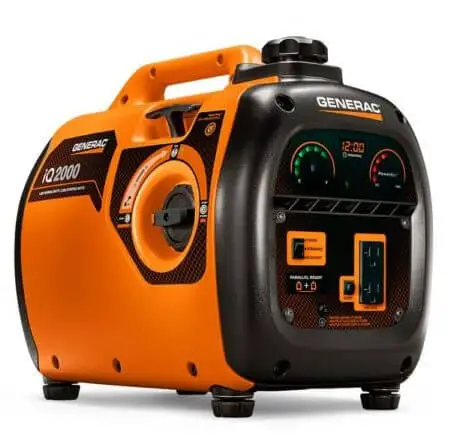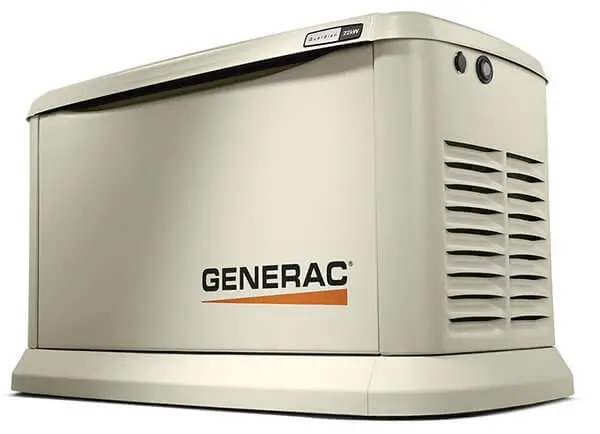One of the first things to go during many disasters is electricity. The obvious way to fix this problem is to buy a generator to power your essentials. When getting ready to buy a generator, ensure you’re getting one that meets your power needs.
To figure out what size generator you need, you first need to determine the running voltage and starting voltage of all the electronic devices you want to run. Then, find a generator that will provide at least that much surge and running wattage. You can run most of your essentials in an average house with a 7,500-watt generator.
It sounds like an easy question, but many factors must be considered. What is rated watts? What do surge watts mean? The power requirements for my device are listed in amps; how do I figure out if the generator can run it? These are questions that people tend to run into when they first look into a generator. It can all be overwhelming initially if you’re starting from scratch.
This article will answer all of these questions and more.

What are Running and Surge Watts?
Understanding how generators are rated is the starting point for determining how much wattage you need in a generator. It may seem not very clear, but it’s easy.
Put, running (or rated) watts are the maximum number of watts that a generator can continuously output without damaging it. Running wattage is the consistent level of power that a device requires to run. Devices like hot plates and light bulbs typically only have one wattage rating. This is their required running watts.
Surge (or starting) watts are the maximum watts a generator can output for a limited time. This allows the generator to ramp up its power output for a limited time to meet the demands of equipment and appliances that need more wattage to get started. These are almost always items with electric motors, like refrigerators, washers, and driers.
Manufacturers almost always display the surge wattage as the wattage of the generator. Take this WEN 56200i Super Quiet 2000-Watt, for example. It’s labeled as a 2000-watt generator, but that is its surge power level. The running wattage of this generator is 1600 watts. Other displayed ratings, like max power, etc., all refer to the generator’s surge watts.
It’s not a big deal if you know what you’re looking for. Just be sure you read the label carefully, and you’ll be ready.
Most Popular Generators
What Power Needs Do My Electronics Have?
The answer to this question will decide how much power you need in a generator. First, you must determine what you want to run off the generator. Will you try to power your entire house, or do you want to keep your food in the refrigerator from spoiling until the power gets turned back on?
The table below will give you a rough idea of how much power you need to power certain devices. Remember that these are just rough guidelines, and you should get the exact power requirements from the labels on the equipment you plan to run on the generator.
Generator Size Needs by Device
| Kitchen Devices | Running (Rated) Wattage | Surge (Starting) Wattage |
|---|---|---|
| Refrigerator or Freezer | 700 | 1500 |
| Microwave | 1000 | 1000 |
| Coffee Maker | 1750 | 1750 |
| Dishwasher | 700 | 1400 |
| Electric Oven | 2100 | 2100 |
| Hotplate | 1300 | 1300 |
| Household Utilities | Running (Rated) Wattage | Surge (Starting) Wattage |
|---|---|---|
| Furnace Fan | 300-875 | 500-2350 |
| Well Pump | 1000 | 2000 |
| Central Air Conditioner | 3800 | 4950 |
| Electric Water Heater | 4000 | 4000 |
| Window Air Conditioner | 1200 | 2200 |
| Box Fan | 200 | 200 |
| Washing Machine | 1150 | 2300 |
| Household Electronics | Running (Rated) Wattage | Surge (Starting) Wattage |
|---|---|---|
| Television | 140-300 | 140-300 |
| Desktop Computer | 600-800 | 600-800 |
| Laptop | 65 | 65 |
| Charging Mobile Devices | 10-12 | 10-12 |
| Electric Grill | 1650 | 1650 |
| Space Heater | 1800 | 1800 |
| Radio/CD/DVD Player | 50-200 | 50-200 |
| Power Tools | Running (Rated) Wattage | Surge (Starting) Wattage |
|---|---|---|
| Circular Saw | 1400 | 2300 |
| Table Saw | 1800 | 4500 |
| 1 HP Air Compressor | 1600 | 4500 |
| Battery Charger | 2400-7800 | 2400-7800 |
| Bench Grinder | 1400 | 2500 |
| Drill | 600 | 900 |
| Electric Welder | 5000 | 5000 |
Figuring Out Power Requirements for a Device if it’s Listed in Amps
Figuring out the power requirements for a device if it’s listed in amps is easy.
Wattage is determined by multiplying volts x amps.
Most generators output 120 volts.
So if a device needs ten amps to power it, you would multiply 120 volts x 10 amps to figure out that you need 1200 watts of power to run it.
How Do We Determine our Power Needs?
Now that we understand the basics of how generators are rated and what the rating means let’s look at how we figure out the exact generator size we need.
Remember that this will be the least powerful generator running your appliances or devices. The more power your generator can output, the more items you’ll be able to power.
In the first example, we’ll say that we want to power the minimum number of things needed during a power outage.
| Scenario #1 | Running (Rated) Wattage | Surge (Starting) Wattage |
|---|---|---|
| Space Heater | 1800 | 1800 |
| Laptop | 65 | 65 |
| Charge Phones/Devices | 12 | 12 |
| Hot Plate | 1300 | 1300 |
| Total | 3,177 | 3,177 |
In this scenario, we’ve determined that we want to be able to charge our phones, run a space heater, charge our laptops and cook on a hotplate. So if we wanted to run everything at once, we’d need 3177 running watts. Something like a DuroStar DS4000S would be sufficient. If we decided not to run the heater and hot plate together, we could drop down to a 2000-watt generator.
In the second example, we’ll say we’re looking for a generator to provide backup power for our house.
| Scenario #2 | Running (Rated) Wattage | Surge (Starting) Wattage |
|---|---|---|
| Central Air Conditioning | 3800 | 4950 |
| Electric Water Heater | 4000 | 4000 |
| Refrigerator or Freezer | 700 | 1500 |
| Microwave | 1000 | 1000 |
| Dishwasher | 700 | 1400 |
| Electric Oven | 2100 | 2100 |
| Well Pump | 1000 | 2000 |
| Furnace Fan | 600 | 1500 |
| Electric Water Heater | 4000 | 4000 |
| Television | 300 | 300 |
| Laptop | 65 | 65 |
| Total | 18,265 | 22,815 |
In this scenario, we’re looking for something to power our entire home during a power outage. This is going to take a much larger and more expensive generator.

This example would need a Generac 7043 Guardian Series 22kW/19.5kW standby generator. A standby generator for your home is great because it’s already wired in and can seamlessly switch on when the power goes out.
Generator Frequently Asked Questions
These are some of the questions we see asked the most when this topic comes up. It’s understandable, as generators aren’t something that many people have a lot of experience with.
How much power do I need for a hurricane?
You could easily substitute pretty much any natural disaster in for a hurricane. The answer is going to be the same for the most part.
You may only need a small generator to run the bare necessities in this case. A small 2000-watt portable generator would suffice if you only expect to be without power for a few days. If you expect to be without power for much longer, a larger generator capable of running your refrigerator and several other appliances simultaneously would be a good idea.
How much power do I need for my house?
This is the second most popular question that comes up about generators. We’ve answered this already, but you’ll want to look for a standby generator if you’re looking for seamless power to your house when the main power goes out.
How much power do I need for an RV?
The most power you’ll need will be to power the RV air conditioning, so that’s a good place to start. After that, you must add the power needed for the rest of your appliances.
One thing to consider is going to be the weight of the generator. Since you’re going to want to be able to run it inside your RV and outside, you’ll want something relatively light. This is why we suggest getting two 2000-watt generators that can be run in series like the Honda EU2200i 120-Volt Portable Inverter with Companion and Parallel Cables. These can be moved separately but will double their power generation by being hooked together.
These are a good set-up for homes as well.
Where should I place my generator?
Always use your generator in a well-ventilated area away from doors, windows, or any vents that may allow carbon monoxide into your home. This cannot be easy when you have to run extension cords to appliances inside the home.
We suggest using a battery-powered carbon monoxide detector in every living space within your home while using a generator. If you’re already spending hundreds of dollars on a generator, spending $10 for a CO detector is a no-brainer.
What are the carbon monoxide concerns associated with a generator?
Traditional fossil fuel-powered generators produce carbon monoxide just like other engines. Carbon monoxide has no smell and cannot be seen.
If you’re working around a generator and begin to feel dizzy, sick, or light-headed, you must immediately get fresh air! Symptoms can come quickly and without warning.
What are the electrical hazards associated with a generator?
When using a generator, you have to make sure you keep it dry. Generators must be set up on the dry ground, and users should ensure their hands are dry before touching the generator or plugging in any cords.
This can be difficult when you consider that one of the times we’re most likely to use a generator is during a natural disaster that probably includes flooding or heavy rainfall. To counter this, we need to plan for wet conditions when we set up or purchase a generator.
To keep a generator dry during a storm, use a tarp or other open covering to keep as much water off the generator as possible. Placing the generator on a raised stand is a good way to keep the generator off of the wet ground.
What are the fire hazards associated with a generator?
The fire hazards that go along with generators are pretty small. The main fire hazard comes from storing fuel and refueling.
When refueling a generator, ensure it’s turned off and has time to cool so that spilled fuel does not pour onto the hot parts of the generator. Storing fuel should be done outside of your living area.
Conclusion
Buying a generator for an emergency is a great option for anyone who is preparedness-minded. Generating your power can add a lot of versatility to your preparedness plans.
Buying a whole-house standby generator is an expensive option that most people probably won’t decide on. On the other hand, a portable generator can be a great choice for short-term power outages.




